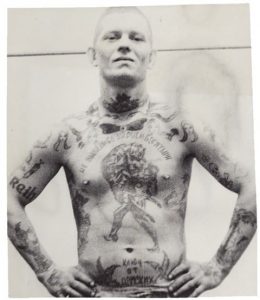The Story of Russian Prison Tattoos
The Russian prison system has been getting a lot of press lately due to the incarceration of political opposition leader Alexei Navalny. He is currently held in a notorious penal colony in Vladimir, a couple of hours from Moscow, on a two-year plus sentence for alleged parole violations. Prisons in Russia are not exactly known for their clemency and coziness. The culture of tattooing in Russian prisons is equally grim, but incredibly fascinating.
Still stigmatized with the older generations
When Russians get tattoos, their parents may have just a slightly harder time accepting it than most other European parents. Tattoos have been linked to criminals, outlaws, and brigands all over for hundreds of years. In much of the world, this is no longer the case and even though much of tattoo technique and ingenuity has its roots in the prison systems, it has grown into a widely accepted, nearly mainstream art form.

Meanwhile, in Russia, for the older generation who grew up within the Soviet system, getting one’s body inked means forfeiting career and social standing and for some unknown reason wishing to mark oneself as an outlier – something that in the USSR may well have gotten one into severe trouble.
Many criminal societies and gangs around the world have special markings and codes. The Camorra in Naples, for instance, and the Bloods and Crips of Los Angeles. Not to mention the elaborate body suits of the Yakuza in Japan. But what makes the Russian prison tattoo tradition stand out?
A suit of service records
Just as with sailors’ tattoos, the symbols on their bodies signify various things – hierarchy, type of crimes committed, and length of time spent in prison. They serve as a ‘service record’, and to misappropriate a tattoo to which you have no right can be punished.
Up until the 1970s, a wrongly inked fellow would be forced to remove the tattoo by cutting or sandpapering if they were lucky, but could also end up paying with their lives for the insubordination. This rule was abolished by criminal leaders as tattoos started to become fashionable in juvenile detention centres, leading to a high number of ‘unearned’ body art.
 Inspired by visual propaganda
Inspired by visual propaganda
Soviet time prison tattoos were a response to the heavy visual propaganda prevalent across the USSR. Very often, prisoners would also display their hatred of or rebelliousness against the authorities. The double-headed eagle – a Russian state-symbol since the 15th century – could be seen adorn chests or abdomens, often along with images of the orthodox church. As religious practices were banned in the Soviet Union, such motives were also part of the rebellious stance against the state.
Other religious symbols were common, such as the Virgin Mary holding baby Jesus, saints and angels, which both ask for protection and represent a devotion to thievery. Meanwhile, epaulettes on the shoulders were worn both as a means of declaring rank in a criminal organisation, and as a mockery of the army and authoritarian system.
Come back next week as we look into more of the meanings behind the body art of some of the most dangerous and notorious places in the USSR.
